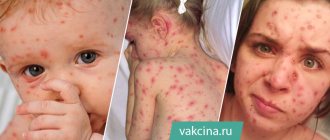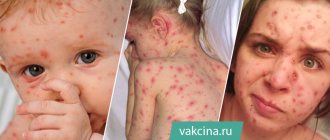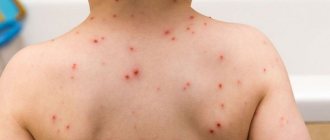Chickenpox is an infectious disease caused by the Varicella Zoster virus. The disease is highly contagious. Transmitted by airborne droplets or contact. A healthy person only needs to interact with a sick person for about 5-10 minutes to catch the virus. Chickenpox in children is most often observed at the age of 4–5 years, when the child’s body is most susceptible to infection. A child up to one year old is protected from the disease by the mother’s antibodies, which are transferred to him during pregnancy and breastfeeding. Children usually tolerate chickenpox quite easily. The incubation period lasts from 5 days to three weeks.
Symptoms of chickenpox in children
The initial manifestations of the disease resemble typical signs of a viral infection and are expressed in:
- sore throat;
- general malaise, weakness, body aches;
- capricious behavior;
- sleep disturbance;
- loss of appetite;
- headache;
- increase in body temperature. The more severe the disease, the higher the thermometer rises. With mild flow, the temperature may remain within normal values or rise slightly.
- A severe form of chickenpox is accompanied by vomiting, and the lymph nodes may become enlarged.
Simultaneously with the rise in temperature, a rash appears on the child’s body, by which chickenpox can be distinguished from other infectious diseases. Rashes with this disease are observed in the vast majority of cases. And even the mildest form is accompanied by a minimal amount of characteristic bubbles.
The rash is first noticed on the body, then on the arms, legs and head. There are no blisters on the feet and palms, but they often appear on mucous membranes: in the mouth, on the tongue and palate, on the genitals and eyes. Small red spots quickly turn into papules that resemble insect bites. Then liquid forms inside them. After the bubble is opened, a crust appears on it. The whole process is accompanied by severe itching, which causes discomfort to the child and sometimes even interferes with proper sleep. If the inflammations are not scratched, they will disappear without a trace soon. Otherwise, scratching may leave small scars on the skin.
It is important to explain to your child that you should not pick off scabs or scratch the inflamed areas, as you can introduce infection into the wounds, which will lead to complications.
The symptoms described above are typical manifestations of chickenpox. Atypical forms come in several types:
- bullous chickenpox with large purulent vesicles;
- hemorrhagic with bloody contents of vesicles;
- gangrenous-necrotic, in which the vesicles are filled with both blood and pus;
- rudimentary, which occurs without a rash and fever, only with typical signs of ARVI.
It is impossible to say for sure how many days chickenpox lasts. The first rash may appear on the first or second day of illness, the last - after a week or a week and a half. Healing of the skin will occur in one to two weeks. If there are complications, the illness may last for several weeks.
On what day is the certificate issued?
The certificate is issued after the child has recovered. Only a doctor can accurately determine the length of time a patient will stay at home. On average, a child is discharged 17-18 days after the onset of the disease.
Children with chickenpox rarely stay at home for more than 21 days. Doctors do not recommend staying isolated from other children any less. If complications develop, parents may have their sick leave extended for a longer period of time.
Treatment of chickenpox in children
Even with a mild course of the disease, a pediatrician should monitor the child’s condition and prescribe medications. Therefore, a doctor should be called to your home at the first suspicion of chickenpox. A set of measures for this disease usually includes the following.
- A sick baby is isolated so that he does not infect others, since there are some groups of people (pregnant women, elderly people and people with chronic diseases) for whom chickenpox can be extremely dangerous.
- Strict bed rest is prescribed for severe cases of the disease or limit physical activity if the disease is mild.
- When treating chickenpox, if no complications are observed, do not use antiviral drugs and antibiotics.
- The child should be offered to drink a lot: clean water, tea, fruit drinks.
- The diet should be as light as possible: soups, steamed fish and meat, pureed fruits and vegetables (if there is a rash on the oral mucosa).
- Suitable drugs based on ibuprofen and paracetamol are used as antipyretics.
- To treat the rash, antiseptics are used: fucorcin, brilliant green, hydrogen peroxide, potassium permanganate, zinc-based products.
- If the itching is severe, your doctor may prescribe antihistamines.
- If a rash forms in the mouth, the pediatrician will recommend rinsing with furatsilin and herbal decoctions. Painful wounds can be lubricated with anesthetic gels.
- If there are scars left after chickenpox, they are lubricated with special products prescribed by the doctor.
How many children and adults are on sick leave with chickenpox?
In childhood, a person has to deal with various infections and bacteria, which cause trouble not only for the child, but also for the parents. Chickenpox is one of the childhood diseases that a child catches as soon as he goes to preschool or before. The virus spreads quickly and is transmitted through the air through communication, so the sick person is isolated from society and sent to sick leave. Many parents are interested in what the incubation period is for chickenpox and how long they spend on sick leave with a child or an adult. On the forums there are numbers from 5 days to three weeks. Therefore, let's study the situation in more detail.
Tips after chickenpox
The main recommendations after chickenpox are to restore and strengthen the immune system, namely:
- long walks in the fresh air;
- use of vitamin supplements;
- limiting physical activity;
- medical exemption from preventive vaccines for at least 1 month.
After suffering from chickenpox, the body acquires stable 100% immunity. There are cases of re-infection, but the clinical manifestations of the disease are less pronounced due to the presence of antibodies to chickenpox in the blood.
When did chickenpox start?
Chickenpox has been known since ancient times. For some time it was considered a mild form of smallpox, and only in 1772 was it identified as a separate disease. And in 1909, it was found that chickenpox and shingles have the same pathogen, which was later confirmed by laboratory tests. Subsequent study of the virus led to the development of a live attenuated varicella vaccine in Japan in the 1970s. The vaccine was licensed for use in the United States in March 1995.
How many days does chickenpox last?
The duration of chickenpox may be different for each patient, since this factor depends on the person individually and the state of his immune system, how well it is ready to fight and resist the virus.
Chickenpox occurs in four stages, each of which is characterized by certain symptoms and duration.
- Incubation period. The duration of chickenpox is from one to three weeks. This is the time when viral agents in the human body multiply very actively, but visible signs of pathology are not yet felt by either the patient or his environment.
- The period of harbingers. The duration of this period ranges from 1 to 3 days. At this time, the patient begins to feel the first signs of possible pathology in the body. Symptoms begin to develop when the chickenpox virus is already in the blood. At first, chickenpox can be confused with an acute respiratory viral infection.
- The period of formation of reddish rashes with blisters that contain serous fluid. Duration from three to ten days. During this period, the virus has already penetrated deeply into the layers of the skin.
- Recovery. Lasts only five days. During this period, the blistering rashes begin to dry out little by little and a crust begins to form. At this time, the patient can already communicate with other people, that is, the quarantine ends, and he can also take water procedures.
After preliminary calculations, we can make a conclusion about the number of days from the beginning of the pathology to its end - this is about twenty days. 10 days is the incubation period when a child or adult does not know that he is infected. The maximum period that chickenpox can last is forty days. And, unfortunately, for twenty days he does not even know that he is sick, and spreads the disease to the masses.
Chickenpox quarantine: how many days do you need to stay at home?
Chicken pox is a disease that is very quickly transmitted from a patient to healthy people; outbreaks of the disease are especially common in places where there are large crowds of people. Taking into account the age group, it can be noted that chickenpox in children develops in kindergartens and schools. Like any disease, chickenpox has several stages of development. Each stage lasts a certain period of time; therefore, there is a quarantine for chickenpox, which must be observed without fail if you do not want to aggravate the patient’s condition and infect healthy people.
What methods exist for diagnosing chickenpox?
Usually the diagnosis is made on the basis of the clinical picture and an objective examination of the patient.
To confirm the diagnosis using laboratory methods, blood, cerebrospinal fluid, and the contents of vesicles and pustules are taken. Microscopy is used as an oriented method.
In modern practice, serological diagnostic methods are used (ELISA, RSK, RNGA, RIA). In this case, blood is taken twice: at the beginning of the disease and during the period of convalescence. The reaction is considered positive if the antibody titer increases 4 times or more.
It is worth noting that ELISA and PCR are the most commonly used. There is also a method for cultivating the virus, but due to labor intensity and high costs, it is not currently used.
How to treat chickenpox?
Patients with an uncomplicated course are most often treated at home. Elements of the rash are treated with a concentrated solution of potassium permanganate. The oxygen that is released as a result of this prevents the addition of a secondary infection and also reduces itching. For a small number of rashes, you can use brilliant green.
Only in severe or complicated cases is treatment directed at the pathogen necessary. These are drugs acyclovir, valacyclovir, famciclovir, which can only be taken after consulting an infectious disease specialist or family doctor. Antiviral treatment is mandatory for herpes zoster. Local application of acyclovir ointments is also possible.
If the itching is severe, those with chickenpox should take antihistamines. For severe pain in patients with herpes zoster - analgesics. If there is a high temperature and severe intoxication, detoxification therapy (intravenous administration of certain solutions) is indicated. Immunoglobulin is indicated for persons who have a reduced level of immunity.
What is quarantine and why is it needed?
Chicken pox is one of the most common diseases in children aged 1 to 7 years. Those children who attend kindergartens are most susceptible to the disease. Since the disease is spread by airborne droplets, one sick child can infect all preschool children in his group, if they have not been sick before. Therefore, kindergartens are introducing a quarantine regime.
Quarantine is a set of activities carried out by the management of a kindergarten, school, hospital in order to prevent the spread of an infectious disease and eliminate its source.
As soon as the first child in a kindergarten group falls ill, the teachers and management of the preschool institution must be notified. The garden's medical worker introduces a quarantine regime. For chickenpox it is 21 days. This means that if after 21 days there are no new cases of chickenpox, the quarantine will be lifted. If there are new cases, the quarantine will be extended for another 21 days each time.
How many days after chickenpox can you go to kindergarten?
During the quarantine period, the group in the kindergarten lives a normal life, but with some peculiarities. A medical worker is required to examine all children every day and measure their temperature. This is done to ensure timely detection of new cases of chickenpox. Children in quarantine usually do not take part in general activities and do not go to the gym, swimming pool or music room.










